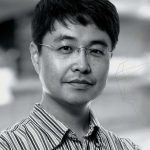Pamela Maher, a senior staff scientist in the lab of Dave Schubert, found further evidence that a natural compound in strawberries reduces cognitive deficits and in inflammation associated with aging in mice. The work, which appeared in the Journals of Gerontology Series A in June 2017, builds on the team’s previous research into the antioxidant fisetin, finding it could help treat age-related mental decline and conditions like Alzheimer’s or stroke.
Read News ReleaseDiscoveries
New method to rapidly map the “social networks” of proteins
Professor Joseph Ecker and collaborators from UC San Diego developed a new high-throughput technique to determine which proteins in a cell interact with each other. Mapping this network of interactions, or “interactome,” has been slow going in the past because the number of interactions that could be tested at once was limited. The new approach, published June 26, 2017, in Nature Methods, lets researchers test millions of relationships between thousands of proteins in a single experiment.
Read News ReleaseTilted microscopy technique better reveals protein structures
The conventional way of placing protein samples under an electron microscope during cryo-EM experiments may fall flat when it comes to getting the best picture of a protein’s structure. In some cases, tilting a sheet of frozen proteins—by anywhere from 10 to 50 degrees—as it lies under the microscope, gives higher quality data and could lead to a better understanding of a variety of diseases including influenza and HIV, according to new research led by Helmsley-Salk Fellow Dmitry Lyumkis. The work appeared in Nature Methods on July 3, 2017.
Read News ReleaseSubway networks mimic plant architectures
How plants grow like human brains
Plants and brains are more alike than you might think.
Salk scientists Saket Navlakha, Charles Stevens, Joanne Chory and colleagues discovered that the mathematical rules governing how plants grow are similar to how brain cells sprout connections.
The team gathered data from 3D laser scans of plants to build a statistical description of theoretically possible plant shapes by studying the plant’s branch density function, which depicts the likelihood of finding a branch at any point in the space surrounding a plant. Basically, this says that branch growth is densest near the plant’s center and gets less dense farther out following a bell curve. This property turned out to be universal regardless of a plant’s growth conditions (sun versus shade, for example). The work, published in Current Biology on July 6, 2017, and based on data from 3D laser scanning of plants, suggests there may be universal rules of logic governing branching growth across many biological systems.
Read News ReleaseSalk scientists solve longstanding biological mystery of DNA organization
Early gene-editing success holds promise for preventing inherited diseases
Protein turnover may be useful marker of aging
It may seem paradoxical, but studying what goes wrong in rare diseases can provide useful insights into normal health. Probing the premature aging disorder Hutchinson-Gilford progeria, Salk Vice President, Chief Science Officer and Professor Martin Hetzer and Staff Scientist Abby Buchwalter have uncovered an errant protein process in the disease that could help healthy people as well as progeria sufferers live longer. When a cell devotes too much time to protein production, other important functions may be neglected. The work, described in Nature Communications on August 30, 2017, adds to a growing body of evidence that reducing protein synthesis can extend lifespan—and thus may offer a useful therapeutic target to counter both premature and normal aging.
New kinds of brain cells revealed
Under a microscope, it can be hard to tell the difference between any two neurons, the brain cells that store and process information. So scientists have turned to molecular methods to try to identify groups of neurons with different functions. Professor and HHMI Investigator Joseph Ecker, Senior Staff Scientist Margarita Behrens, Research Associate Chongyuan Luo and collaborators have, for the first time, profiled chemical modifications of DNA molecules in individual neurons, giving the most detailed information yet on what makes one brain cell different from its neighbor. The work appeared in Science on August 10, 2017.
Partnership for a healthy brain
Professor Rusty Gage, Professor and Chief Science Officer Martin Hetzer, first author Tomohisa Toda and colleagues have discovered that an interaction between two key proteins in the cell nucleus helps regulate and maintain the cells that produce neurons. The work, published in Cell Stem Cell on September 14, 2017, offers insight into why an imbalance between these precursor cells and neurons might contribute to mental illness or age-related brain disease. The immune system automatically destroys dysfunctional cells such as cancer cells, but cancerous tumors often survive nonetheless.
Read News ReleaseMicroRNA helps cancer evade immune system
The right way to repair DNA
Is it better to do a task quickly and make mistakes, or to do it slowly but perfectly? When it comes to deciding how to fix breaks in DNA, cells face the same choice between two major repair pathways. The decision matters, because the wrong choice could cause even more DNA damage and lead to cancer. Professor Jan Karlseder and first author Nausica Arnoult found that a tiny protein called CYREN helps cells choose the right pathway at the right time, clarifying a longstanding mystery about DNA repair and offering researchers a powerful tool that could guide better treatments for cancer.
Read News ReleaseFeatured Stories
 Harnessing plants for the futureGet ready, sunny San Diego: Winter is coming. We’re not talking about a new season of Game of Thrones—although the story is one of epic proportions and high stakes.
Harnessing plants for the futureGet ready, sunny San Diego: Winter is coming. We’re not talking about a new season of Game of Thrones—although the story is one of epic proportions and high stakes. Sung Han was destined for SalkHan, an assistant professor in the Clayton Foundation Laboratories for Peptide Biology, arrived at the Institute a year ago to study how the brain recognizes aversive sensory signals.
Sung Han was destined for SalkHan, an assistant professor in the Clayton Foundation Laboratories for Peptide Biology, arrived at the Institute a year ago to study how the brain recognizes aversive sensory signals.  All roads lead to science for Elena Blanco-SuárezFrom early on, it was pretty much a given that Elena Blanco-Suárez would be a scientist.
All roads lead to science for Elena Blanco-SuárezFrom early on, it was pretty much a given that Elena Blanco-Suárez would be a scientist.




















































